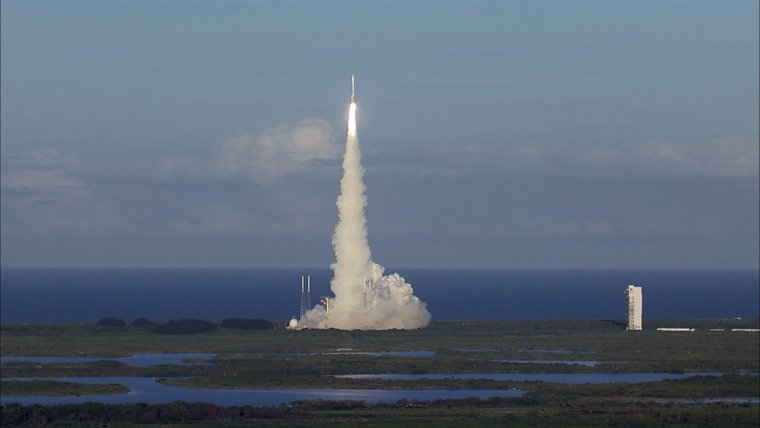| News / Science News |
Evening Launch Catapults OSIRIS-REx Toward Asteroid Encounter
NASA | SEPTEMBER 9, 2016
An Atlas V rocket traced a blazing arc into the Florida sky Thursday evening to send a small robotic explorer on its way to an asteroid on a mission that scientists anticipate will reveal answers to some of the basic questions about the solar system.

A United Launch Alliance Atlas V rocket lifts off from Space Launch Complex 41 at Cape Canaveral Air Force Station carrying NASA’s Origins, Spectral Interpretation, Resource Identification, Security-Regolith Explorer, or OSIRIS-REx spacecraft on the first U.S. mission to sample an asteroid. ![]()
Lifting off at 7:05 p.m. from Space Launch Complex 41 at NASA's Kennedy Space Center in Florida, the rocket's launch was timed to put the OSIRIS-REx spacecraft, short for Origins, Spectral Interpretation, Resource Identification, Security-Regolith Explorer, on an exact course to reach the asteroid Bennu in August 2018.
Burning a combination of refined kerosene called RP-1 and liquid oxygen and carrying a single solid-fueled booster, the first stage of the United Launch Alliance Atlas V 411 pushed the spacecraft through the dense lower layers of the atmosphere, then the Centaur upper stage took over, propelling OSIRIS-REx faster and higher.
About 55 minutes after launch, the asteroid sampling spacecraft separated from the liquid oxygen and liquid hydrogen fueled second stage rocket to fly free.
OSIRIS-REx will make a swing by Earth next year to gain a gravity assist that will accelerate it even faster to reach Bennu, where it will eventually go into orbit. Once orbiting the asteroid, OSIRIS-REx will spend two years surveying it in unprecedented detail.
Then, in a robotic first, the spacecraft will reach out its mechanical arm and take a sample from the asteroid.
Though the sample will be small – only a couple of pounds at most – it will be a time capsule of sorts recording our solar system's creation. With the sample stored safely, the spacecraft will speed away from the asteroid on a path back to Earth.
Nearing Earth's atmosphere seven years from now, a capsule containing the sample and equipped with a heat shield will detach from the main OSIRIS-REx spacecraft and enter Earth's atmosphere.
A parachute will slow the capsule down so it can be retrieved, then researchers will go about examining the precious cargo taken directly from an asteroid.
YOU MAY ALSO LIKE



